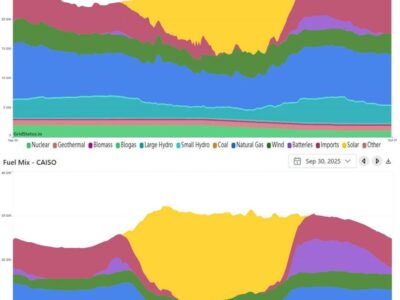Can California Try Again with Vehicle Pollution Limits?
A new Sixth Circuit decision provides encouragement.
In May, Congress effectively killed the most recent efforts by California to clean up its vehicle fleet. Although many people seem to have assumed the contrary, this may not be the end of the road for California regulators. A new court of appeals decision is an encouraging signal that California may be able try again when the political forces in DC are less militantly anti-environmental.
Background.
The issue involves two different laws. The first is the Clean Air Act (CAA)., Under the CAA, states are generally barred from imposing restrictions on vehicle emissions. There’s an exception, however, for California and for other states adopting California regulations. To take advantage of the exception, California must apply to EPA for a waiver of federal preemption. The Biden Administration gave waivers to three California laws that each would probably have led to much greater use of electric vehicles.
The second law, and the one involved in the new case, involves the Congressional Review Act (CRA). Under the CRA, Congress has a certain amount of time in which it can overturn a new federal regulation. That’s what Congress did with the EPA waivers. (I’m on record arguing that the waivers weren’t regulations, so that the CRA didn’t really apply. But let’s put that aside. ‘
Standing alone, the part of the CRA about Congressional disapproval would know out the specific regulation submitted to Congress but wouldn’t affect future regulations. But another provision of the CRA provides that “a rule that does not take effect (or does not continue) . . . may not be reissued in substantially the same form, and a new rule that is substantially the same as such a rule may not be issued, unless the reissued or new rule is specifically authorized.” The big problem is that no one has really known what “substantially the same” means. For that reason, agencies have been reluctant to return to issues at all after a CRA resolution.
The Sixth Circuit Decision.
The Sixth Circuit case, Ohio Telecom Association, involved an FCC regulation that required telecom companies to report data breaches involving personal information like passwords medical information, and social security numbers. The rule was challenged by companies who apparently don’t want to bother protecting their customers. A previous regulation that included some broadly similar requirements — among various other requirements — was overturned by Congress. The industry argued that the new regulation was substantially similar to the related provision in the old rule, although different from various other parts of the old rule dealing with other topics.
Before addressing this issue, the Sixth Circuit first had to consider whether it had jurisdiction. Another provision of the CRA provides: ““No determination, finding, action, or omission under this chapter shall be subject to judicial review.” The court said that the case involved a challenge to the new FCC regulation, which was “under” federal communication laws rather than the CRA.
That seems overly hasty. It’s true that the regulation wasn’t issued under the CRA. But the bar on judicial review isn’t limited to “actions.” It also includes any “determination” or “finding.” And the FCC did find that its new rule was not substantially the same as the old one. It’s not at all clear that Congress meant that finding to be judicially reviewable. On the other hand, maybe Congress had other meanings in mind, such as the finding that an action is a rule subject to the CRA or that the resolution was offered in the relevant time period. That issue deserves more consideration than the court gave it.
In any event, the court proceeded to the merits of the issue. By a two to one vote, it ruled that the new regulation wasn’t substantially the same for two reasons. First, while the new rule was similar to some of the provisions in the old, overturned regulation, it wasn’t similar to the old regulation taken as a whole, which included a lot of other things. And second, even in comparison with the relevant provisions in the old rule, the new one was meaningfully different, mostly in giving more flexibility to the industry.
That holding seems right to me. We know that there were enough objectors in Congress to overturn the old rule. But we don’t know which parts of the old rule were objectionable to a majority of legislators. The CRA doesn’t allow a resolution overturning only part of a rule. In fact, we don’t know that there was a majority against any specific provision: perhaps there were different small groups who hated entirely different provisions, making up a majority when added together. All we really know is that a majority in Congress voted not to let the package as a whole go into effect.
Probably more relevant to the California waiver, the Court also found that there were meaningful difference that meant that the new FCC rule was not substantially the same. These differences weren’t earthshaking, but they weren’t insignificant either. Being “substantially the same” clearly requires more than just being “similar.”
Implications
Assuming the Sixth Circuit decision isn’t overturned, it’s a very helpful precedent for California. It may possible for the state to disaggregate some of its earlier regulations, allowing it to reenact some of the requirements in a given regulation. That needs to be done in a way that makes sense, in that the reenacted pieces have to look severable ferom the remaining parts of the regulation. That may or may not be feasible. But would should be possible is to put forward new regulations that different in meaningful ways such as different deadlines, greater compliance flexibility, or less stringent emission limits.
The Sixth Circuit majority was right to require a high level of similarity between the old regulation and the new one. “Substantially the same” seems to mean that there are no significant differences. In passing the CRA, Congress gave itself the power to overturn specific regulations, not the power to broadly amend earlier statutes. Thus, while the specific waivers before Congress were overturned, the general Clean Air Act requirements governing waivers remain in effect.
The “substantially the same” restriction keeps the agency from redoing the same thing with only cosmetic changes, and it’s understandable that Congress wanted to prevent blatant circumvention of its CRA actions. But given that the Clean Air Act hasn’t been amended, the anti-circumvention rule shouldn’t be read so broadly as to in effect write the waiver provision out of the Clean Air Act.







Reader Comments